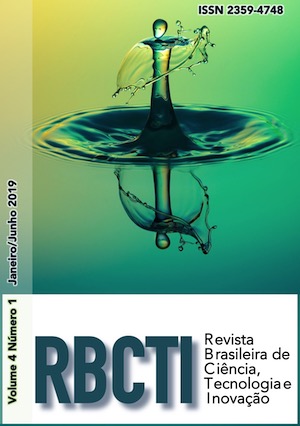Influence of the folded balloon geometry on the Crimping process of Stents
DOI:
https://doi.org/10.18554/rbcti.v4i1.3412Palavras-chave:
Angioplasty, Crimping, Finite elements method, Stents.Resumo
Nowadays, the use of stents during the angioplasty process is a common practice for the artery restenosis. Usually, the structural integrity of the balloon and stent are studied based on the numerical simulation using the finite elements method. In most cases, the geometry of the balloon is considered as a cylinder with thickness constant. However, the balloon is folded before the angioplasty. In this context, the objective of this work is to study the influence of the stress caused by the crimping process in the structural integrity of the stent and the balloon. For the simulation of the crimping process, the geometry of the expandable balloon was considered as a cylinder with folds. This geometry was considered in order to model the balloon without internal pressure before the deployment of the stent. The results have proved that the folded balloon stress distribution caused by the crimping process should be take account in the analysis of the structural integrity of the stent and balloon.Referências
ARAÚJO, R., Desenvolvimento e Avaliação de Geometrias de Stents Cardiovasculares Considerando Parâmetros Mecânicos e de Implantação. Tese de Doutorado, Programa de Pós-Graduação em Engenharia Mecânica, Universidade Federal de Uberlândia, Uberlândia, M.G., Brasil, 2016.
ARAÚJO, R.; OLIVEIRA, S. A. G.; GUIMARÃES, T. A., Numerical Simulation of the Crimping Process in Stents. In: Procedings of the Brazilian Congress of Mechanical Engineering 2009 (COBEM 2009), 2009.
CHUA, S. N. D.; MAC DONALD, B. J.; HASHIMI, M. S. J. Finite Element Simulation of stent and balloon interaction. Journal of Materials Processing Technology, Vol. 143-144, pp. 591 – 597, 2003.
GRUNTZIG, A. R.; SENNING, A.; SIEGENTHALER, W. E. Nonoperative dilatation of coronary-artery stenosis – percutaneous transluminal coronary angioplasty. N Engl J. Med.; Vol. 301, pp 61-8, 1979.
JIE, Y.; MINGBANG, L.; NAN, H.; TIANXUE, Y.; QUANXING, D.; SHUWEN, M. Simulation of the Stent Expansion by Finite Elements Method, IEEE 2009, 2009.
LALLY, C.; DOLAN, F.; PRENDERGAST, P. J. Cardiovascular Stent Design and Vessel Stress: a Finite Elements Analysis, Journal of Biomechanics, Vol. 38, pp. 1574 – 1581, 2005
LANGONI, A. M.; ARAÚJO, R.; OLIVEIRA, S. A. G.; GUIMARÃES, T. A. A Finite Elements Analysis of the Perrformance of Stents fof Angioplasty Using the Hydroforming Process, In: Procedings of the Congress Iberian Latin American of Methods Computacional in Engineering 2006 (CILAMCE 2006), 2006.
LIANG, D. K.; YANG, D. Z.; QI, M.; WANG, W.Q., Finite Elements Analysis of the Implantation of expandable-balloon stent in a stenosed artery. International Journal of Cardiology, Vol. 104, pp. 314 – 318, 2005.
OGDEN, R. W., Nonlinear Elastic Deformations, Ed. Dover Publications, 1984.
RONDEAU, F.; PILET, P.; HEYMANN, D.; CROCHET, D.; GRIMANDI, G. Balloon Surface Changes After Stent Deployment: Influence of the Crimping Technique, Éditions Scientifiques et Medicales, Vol. 23, pp. 357 – 362, 2002.
SERRUYS, P. W.; KUTRYK, M. J. B. Handbook of Coronary Stents, Ed. Martin Dunitz, 1998.






